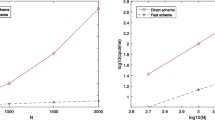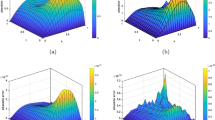Abstract
We study a variant of the Kac–Zwanzig model of a particle in a heat bath. The heat bath consists of n particles which interact with a distinguished particle via springs and have random initial data. As n → ∞ the trajectories of the distinguished particle weakly converge to the solution of a stochastic integro-differential equation—a generalized Langevin equation (GLE) with power-law memory kernel and driven by 1/f α-noise. The limiting process exhibits fractional sub-diffusive behaviour. We further consider the approximation of non-Markovian processes by higher-dimensional Markovian processes via the introduction of auxiliary variables and use this method to approximate the limiting GLE. In contrast, we show the inadequacy of a so-called fractional Fokker–Planck equation in the present context. All results are supported by direct numerical experiments.
Similar content being viewed by others
REFERENCES
M. Abramowitz and I. Stegun, Handbook of Mathematical Functions with Formulas, Graphs, and Mathematical Tables (Dover, New York, 1971).
S. Adelman and J. Doll, Generalized Langevin equation approach for atom/solid-surface scattering: Collinear atom/harmonic chain model, J. Chem. Phys. 61:4242–4245 (1974).
F. Amblard, A. Maggs, B. Yurke, A. Pargellis, and S. Leibler, Subdiffusion and anomalous local viscoelasticity in actin networks, Phys. Rev. Lett. 77:4470–4473 (1996).
E. Barkai, Fractional Fokker-Planck equation, solution and application, Phys. Rev. E 63:046118 (2001).
E. Barkai, R. Metzler, and J. Klafter, From continuous time random walks to the fractional Fokker-Planck equation, Phys. Rev. E 61:132–138 (2000).
E. Barkai and R. Silbey, Fractional Kramers equation, J. Phys. Chem. B 104:3866–3874 (2000).
P. Billingsley, Probability and Measure, 3rd ed. (Wiley, New York, 1995).
P. Billingsley, Convergence of Probability Measures, 2nd ed. (Wiley, New York, 1999).
B. Carmeli and A. Nitzan, Non-Markovian theory of activated rate processes. III. Bridging between the Kramers limits, Phys. Rev. A 29:1481–1495 (1984).
F. de Hoog, J. Knight, and A. Stokes, An improved method for numerical inversion of Laplace transforms, SIAM J. Sci. Stat. Comp. 3:357–366 (1982).
M. Dygas, B. Matkowsky, and Z. Schuss, A singular perturbation approach to non-Markovian escape rate problems, SIAM J. Appl. Aath. 46:265–298 (1986a).
M. Dygas, B. Matkowsky, and Z. Schuss, A singular perturbation approach to non-Markovian escape rate problems with state dependent friction, J. Chem. Phys. 84:3731–3738 (1986b).
A. Erdélyi, Tables of Integral Transforms (McGraw-Hill, New York, 1954).
G. Ford and M. Kac, On the quantum Langevin equation, J. Stat. Phys. 46:803–810 (1987).
G. Ford, M. Kac, and P. Mazur, Statistical mechanics of assemblies of coupled oscillators, J. Math. Phys. 6:504–515 (1965).
C. Fox, The G and H-functions as symmetrical Fourier fernels, Trans. Amer. Math. Soc. 98:395–429 (1961).
I. Gikhman and A. Skorokhod, Stochastic Differential Equations (Springer-Verlag, Berlin, 1972).
I. Gikhman and A. Skorokhod, Introduction to the Theory of Random Processes (Dover, Mineola, NY, 1996).
H. Grabert, P. Hänggi, and P. Talkner, Microdynamics and nonlinear stochastic processes of gross variables, J. Stat. Phys. 22:537–552 (1980).
P. Grigolini, A generalized Langevin equation for dealing with nonadditive fluctuations, J. Stat. Phys. 27:283–316 (1982).
G. Gripenberg, S.-O. Londen, and O. Staffans, Volterra Integral and Functional Equations (Cambridge University Press, Cambridge, 1990).
R. Grote and J. Hynes, The stable states picture of chemical reactions: II. Rate constants for condensed and gas phase reaction models, J. Chem. Phys. 73:2715–2732 (1980).
P. Guest, Laplace Transform and an Introduction to Distributions (Ellis Horwood Ltd, Chichester, England, 1991).
E. Hairer, S. Norsett, and G. Wanner, Solving Ordinary Differential Equations: Nonstiff Problems (Springer-Verlag, Berlin, 1993).
O. Hald and R. Kupferman, Asymptotic and numerical analyses for mechanical models of heat baths, J. Stat. Phys. 106:1121–1184 (2002).
P. Hanggi, The functional derivative and its use in the description of noisy dynamical systems, in Stochastic Processes Applied to Physics, L. Pesquera and M. Rodriguez, eds. (Santander, Spain, 1985), pp. 69–95.
P. Hänggi and F. Mojtabai, Thermally activated escape rate in presence of long-time memory, Phys. Rev. A 26:1168–1170 (1982).
P. Hänggi, P. Talkner, and M. Bokovec, Reaction rate theory: Fifty years after Kramers, Rev. Mod. Phys. 62:251–341 (1990).
W. Huisinga, C. Schütte, and A. Stuart, Extracting macroscopic stochastic dynamics: Model problems, Comm. Pure Appl. Math. 56:234–269 (2003).
V. Jakšić and C.-A. Pillet, Ergodic properties of the non-Markovian Langevin equation, Lett. Math. Phys. 41:49–57 (1997).
I. Karatzas and S. Shreve, Brownian Motion and Stochastic Calculus (Springer, New York, 1991).
R. Kupferman and A. Stuart, Fitting SDE models to nonlinear Kac-Zwanzig heat bath models, submitted to Physica D (2003).
R. Kupferman, A. Stuart, J. Terry, and P. Tupper, Long term behaviour of large mechanical systems with random initial data, Stoch. Dyn. 2:533–562 (2002).
S. Landis, B.-Z. Borovsky, and Z. Schuss, The influence of 1 / f α phase noise on a second-order delay lock loop: Model construction and analysis, preprint, (2003).
B. Mandelbrot and J. van Ness, Fractional Brownian motion, fractional Gaussian noise and applications, SIAM Rev. 10:422 (1968).
J. Masoliver and K. Wang, Free inertial processes driven by Gaussian noise: Probability distributions, anomalous diffusion, and fractal behavior, Phys. Rev. E 51:2987–2995 (1995).
R. Metzler, E. Barkai, and J. Klafter, Anomalous diffusion and relaxation close to thermal equilibrium: A fractional Fokker-Planck equation approach, Phys. Rev. Lett. 82:3563–3567 (1999).
R. Miller, Nonlinear Volterra Integral Equations (W. A. Benjamin, Philippines, 1971).
E. Montroll and G. Weiss, Random walks on lattices. II, J. Math. Phys. 6:167–181 (1965).
H. Mori, A continued-fraction representation of the time-correlation function, Prog. Theor. Phys. 34:399–416 (1965a).
H. Mori, Transport, collective motion, and Brownian motion, Prog. Theor. Phys. 33:423–450 (1965b).
H. Mori, H. Fujisaka, and H. Shigematsu, A new expansion of the master equation, Prog. Theor. Phys. 51:109–122 (1974).
K. Oldham and J. Spanier, The Fractional Calculus (Academic Press, New York, 1974).
J. Porrà, K.-G. Wang, and J. Masoliver, Generalized Langevin equation: Anomalous diffusion and probability distributions, Phys. Rev. E 53:5872–5881 (1996).
W. Schneider and W. Wyss, Fractional diffusion and wave equation, J. Math. Phys. 30:134–144 (1989).
J. Straub, M. Borkovec, and B. Berne, Shortcomings of current theories of non-Markovian activated rate processes, J. Chem. Phys. 83:3172–3174 (1985).
J. Straub, M. Borkovec, and B. Berne, Non-Markovian activated rate processes: Comparison of current theories with numerical simulation data, J. Chem. Phys. 84:1788–1794 (1986).
A. Stuart and J. Warren, Analysis and experiments for a computational model of a heat bath, J. Stat. Phys. 97:687–723 (1999).
H. Wall, Analytic Theory of Continued Fractions (D. Van Nostrand, New York, 1948).
K. Wang, Long-time-correlation effects and biased anomalous diffusion, Phys. Rev. A 45:833–837 (1992).
L. Zadeh and C. Desoer, Linear System Theory: The State Space Approach (McGraw-Hill, New York, 1963).
G. Zaslavsky, Chaos, fractional kinetics and anomalous transport, Physics Reports 371:461–580 (2002).
R. Zwanzig, Nonlinear generalized Langevin equations, J. Stat. Phys. 9:215–220 (1973).
R. Zwanzig, Problems in nonlinear transport theory, in Systems far from Equilibrium, L. Garrido, ed. (Springer, New York, 1980), pp. 198–225.
Author information
Authors and Affiliations
Rights and permissions
About this article
Cite this article
Kupferman, R. Fractional Kinetics in Kac–Zwanzig Heat Bath Models. Journal of Statistical Physics 114, 291–326 (2004). https://doi.org/10.1023/B:JOSS.0000003113.22621.f0
Issue Date:
DOI: https://doi.org/10.1023/B:JOSS.0000003113.22621.f0




